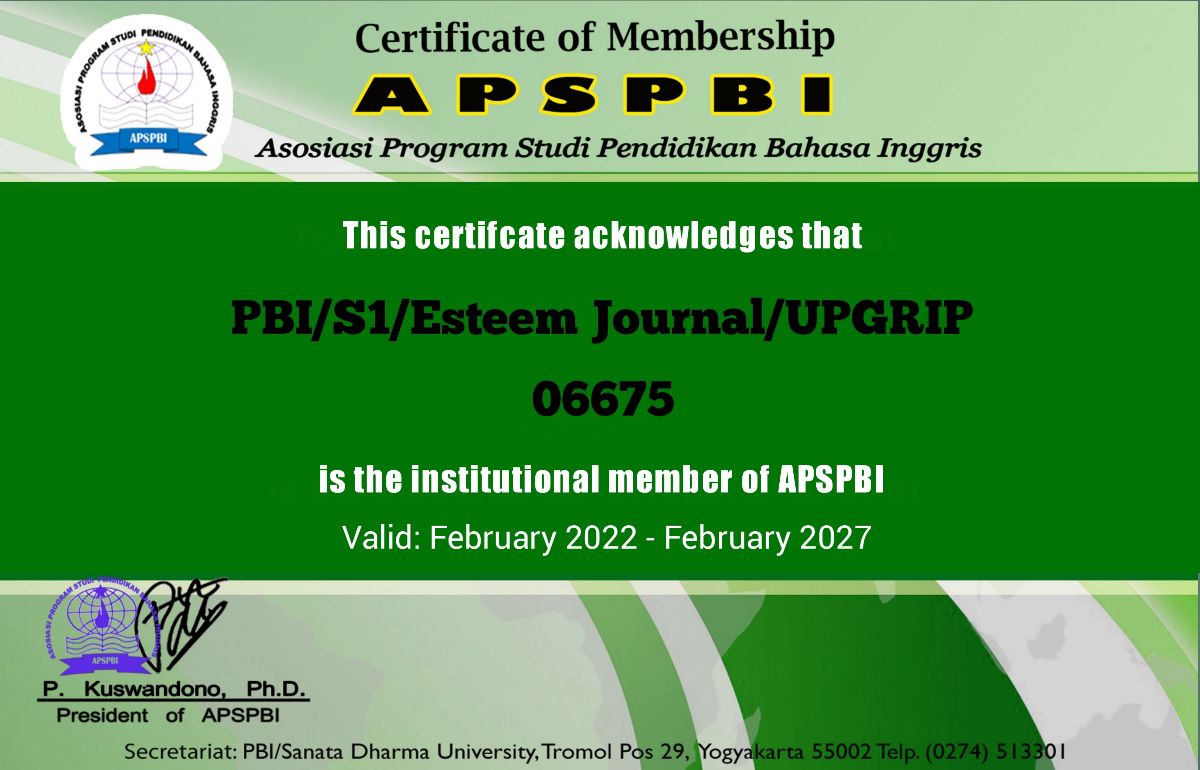CLASSROOM INTERACTION IN COMMUNICATIVE LANGUAGE TEACHING OF SECONDARY SCHOOL
DOI:
https://doi.org/10.31851/esteem.v7i1.12661Keywords:
Communicative Language Teaching, Teacher interaction, Classroom Interaction, Student InteractionAbstract
This research aimed to describe the dynamics of classroom interaction and examine the factors influencing it. The researcher utilized qualitative methods, including classroom observation, semi-structured interviews, and questionnaires. The findings revealed that the teacher predominantly led and controlled the interaction. Good interaction only occurs at the beginning of the lesson, so for the most part, the teacher initiates and the students only responded to the teacher by giving answers in the form of phrases or words. For interaction between students they are interacted with their friends most of the time. But, mostly, it was not related to the English topic discussed. The researcher also found several factors affecting classroom interaction, such as students' lack of motivation, hesitancy to speak and engage in class discussions due to limited vocabulary, embarrassment, and fear of making mistakes.
References
Aghbar, A. A., & Malamah-Thomas, A. (1989). Classroom Interaction. TESOL Quarterly, 23(1), 141. https://doi.org/10.2307/3587519
Akinwamide, T. K., & Akande, Y. J. (2019). Teachers’ Perception Towards the Use of Communicative Language Teaching in Enhancing Secondary School Students’ Communicative Competence in English Language. International Journal of English Language Teaching, 7(4), 6–15. www.eajournals.org
Alijoyo, D. A., Wijaya, B., & Jacob, I. (2009). Structured or Semi-structured Interviews. Crms, 15.
Al-Munawwarah, S. F. (2021). Teacher- Students ’ Interaction in EFL Teaching : Analyzing Patterns of Classroom Interaction. Eralingua: Jurnal Pendidikan Bahasa Asing Dan Sastra, 5(2), 416–435.
Astuti, M. M. (2011). An Analysis Of Classroom Interaction In The English Teaching And Learning Process Of The Bilingual Class In The First Grade Of SMPN 1 Prambanan. UNILA Journal of English Teaching, 2(4), 1–124. https://www.mendeley.com/catalogue/bad325f0-0afc-3073-80a3-53a84cc152bf/
Astutie, S. (2020). An analysis of teacher talk and student talk in English classroom interaction using FLINT system at the ninth grade of SMP Negeri 3 Hulu Sungai Tengah. TEFLA Journal (Teaching English as Foreign Language and Applied Linguistic Journal), 2(2), 24-33.
Cahyati, S. S. (2019). an Analysis of Using English in Classroom Interaction (a Study At the First Grade of a Primary School). PROJECT (Professional Journal of English Education), 1(1), 19. https://doi.org/10.22460/project.v1i1.p19-26
Cha, K. (2015). The Principles and the Ways of Classroom Interaction. Icadce, 844–847. https://doi.org/10.2991/icadce-15.2015.204
Da’ar, G. F. (2016). Communicative language teaching (CLT) and classroom interaction: Implication to the foreign language learning and teaching. Jurnal Pendidikan Dan Kebudayaan Missio, 8(2), 310–315. http://unikastpaulus.ac.id/jurnal/index.php/jpkm/article/view/198
Daar, G. F., & Ndorang, T. A. (2020). Analysis the Implementation of Communicative Language Teaching and Classroom Interaction in the Effort to Increase Learners’ Speaking Skills. International Journal for Educational and Vocational Studies, 2(12), 969–978. https://doi.org/10.29103/ijevs.v2i12.2969
Dagarin, M. (2004). Classroom Interaction and Communication Strategies in Learning English as a Foreign Language. ELOPE: English Language Overseas Perspectives and Enquiries, 1(1–2), 127–139. https://doi.org/10.4312/elope.1.1-2.127-139
Eisenring, M. A. A., & Margana, M. (2019). the Importance of Teacher – Students Interaction in Communicative Language Teaching (Clt). PRASASTI: Journal of Linguistics, 4(1), 46. https://doi.org/10.20961/prasasti.v4i1.17052
Farr, B. C. (2008). Designing Qualitative Research. Transformation: An International Journal of Holistic Mission Studies, 25(2–3), 165–166. https://doi.org/10.1177/026537880802500310
Febriansyah, A. H. (2014). Efforts to improve classroom interaction in english teaching-learning process through communicative tasks to the 8th Grade Students of SMPN 3 Wates. 188.
Fraenkel, jack R., Wallen, N. E., & Hyun, H. N. (2012). how to design and evaluate research in education (eight). McGraw-Hill.
Gustiani, S. (2013). the Communicative Language Teaching: Review on Own Experience in Elt At English Department, Sriwijaya State Polytechnic, Palembang. Epigram, 9(1), 16–22. http://jurnal.pnj.ac.id/index.php/epigram/article/view/42
Hafen, C. A., Hamre, B. K., Allen, J. P., Bell, C. A., Gitomer, D. H., & Pianta, R. C. (2015). Teaching Through Interactions in Secondary School Classrooms. The Journal of Early Adolescence, 35(5–6). https://doi.org/10.1177/0272431614537117
Hancock, B. (2006). An Introduction to Qualitative Research Au t hors. Qualitative Research, 4th, 504. https://doi.org/10.1109/TVCG.2007.70541
Hasanah, A. U. (2023). Journal of English Language Teaching The Analysis of Teacher-Student Interaction on Student Motivation. 12(1), 138–143. https://doi.org/10.24036/jelt.v12i1.121811
Jasim, A. F. (2020). The Impact of Using Classroom Interaction on Teaching English Grammar for 1st Year Iraqi EFL University Learners. International Journal of Innovation, Creativity and Change, 13(9), 1081–1095.
Kamaruddin, J. (2020). Achieve Classroom Interaction In English Learning. 1(1).
Kurniatillah, R. E., Hidayat, D. N., Husna, N., & Alek, A. (2022). Teacher-student interaction in English classroom setting. Journal of Applied Studies in Language, 6(1), 53–63. https://doi.org/10.31940/jasl.v6i1.391
Kurniawati, A. Y. U., & Humanities, F. O. F. (2019). The Dynamics Of English Interaction In.
Languages, E., & Studies, T. (2022). Linguistics and English Languages Teaching Studies. 3(2).
Mardhiyah, A., Jaya, A., & Uzer, Y. (2023). Students’ Speaking Ability Through Small Group Discussion. Esteem Journal of English Education Study Programme, 6(1), 81–86. https://doi.org/10.31851/esteem.v6i1.10216
Nurul Afifah, Nopa Yusnilita, V. R. R. (2017). Volume 8, No. 2, August 2017. ETERNAL (English Teaching Journal), 8(2), 2–12. http://journal.upgris.ac.id/index.php/eternal/article/download/2830/2074
Pistarman. (2015). the Forms of Classroom Interaction Found in English. 2(2).
Putri, A. D., Jaya, A., & Marleni, M. (2023). Exploring the Students’ Speaking Ability Based on Their Different Personalities. Esteem Journal of English Education Study Programme, 6(1), 10–16. https://doi.org/10.31851/esteem.v6i1.10203
Rambe, S. L. V. (2020). Varying Interaction Patterns to Create Communicative Teaching and Learning. English Journal for Teaching and Learning, 08(01), 91–100. http://jurnal.iainpadangsidimpuan.ac.id/index.php/EEJ%0AVarying
Ramli, M. (2018). Classroom Interaction: Teacher and Students Perception on Dialogue in Primary Science Classroom. Edusains, 10(1), 127–134. https://doi.org/10.15408/es.v10i1.8092
Rido, A., & Sari, F. M. (2018). Characteristics of classroom interaction of english language teachers in Indonesia and Malaysia. International Journal of Language Education, 2(1), 40–50. https://doi.org/10.26858/ijole.v2i1.5246
S, W., Nasmilah, N., Khan, A., & Mumu, S. (2022). Teacher Talk and Student Talk in English Classroom Interaction Analysis: A Literature Study. https://doi.org/10.4108/eai.14-8-2021.2317642
Safriyani, R. (2018). Classroom Interaction in English Reading Class. https://doi.org/10.2991/iconelt-17.2018.60
Saputra, F. (2019). and the Tenth Grade Students at Sma Al-Falah Islam.
Sari, M. S., & Zefri, M. (2019). Pengaruh Akuntabilitas, Pengetahuan, dan Pengalaman Pegawai Negeri Sipil Beserta Kelompok Masyarakat (Pokmas) Terhadap Kualitas Pengelolaan Dana Kelurahan Di Lingkungan Kecamatan Langkapura. Jurnal Ekonomi, 21(3), 308–315. https://ejournal.borobudur.ac.id/index.php/1/article/view/608/583
Sari, A., Jaya, A., Hermansyah, H., & ... (2022). Using Mixidea Online Debating Strategy To Promote the Students’Speaking Ability. Esteem Journal …, 1–6. https://jurnal.univpgri-palembang.ac.id/index.php/esteem/article/view/8591%0Ahttps://jurnal.univpgri-palembang.ac.id/index.php/esteem/article/viewFile/8591/5938
Savignon, S. J. (1987). Communicative Language Teaching (CLT): An Evolution in Revolution. Theory Into Practice, 26(4), 235–242.
Shinta, I. C. E., & Tedjaatmadja, H. M. (2014). The Implementation of Communciative Language Teaching Approach in a Secondary School in Surabaya. Journal of Langauge, Literature, and Teaching, 2(2), 41–45.
Statements, P., & Statements, C. (n.d.). Positive Teacher-Student Relationship Quick Reference Guide. i, 2–4.
Sugiyono. (2018). Metode Penelitian Kuantitatif, Kualitatif, dan R&D. Alfabeta.
Sundari, H. (2017). Classroom Interaction in Teaching English as Foreign Language at Lower Secondary Schools in Indonesia. Advances in Language and Literary Studies, 8(6), 147. https://doi.org/10.7575/aiac.alls.v.8n.6p.147
Tiwari, T. D. (2021a). Classroom Interaction in Communicative Language Teaching of Public Secondary Schools in Nepal. IJELTAL (Indonesian Journal of English Language Teaching and Applied Linguistics), 5(2), 373. https://doi.org/10.21093/ijeltal.v5i2.766
Xiaolin Jia. (2013). The application of classroom interaction in English lesson. Icetis, 1619–1622. https://doi.org/10.1109/nces.2012.6543782
Downloads
Published
Issue
Section
License
Copyright (c) 2023 Novi Lesiana, Mulyadi, Aswadi Jaya

This work is licensed under a Creative Commons Attribution-NonCommercial-ShareAlike 4.0 International License.
Copyright Notice
Authors who publish with this journal agree to the following terms:
In order to assure the highest standards for published articles, a peer review policy is applied. In pursue of the compliance with academic standards, all parties involved in the publishing process (the authors, the editors and the editorial board and the reviewers) agree to meet the responsibilities stated below in accordance to the Journal publication ethics and malpractice statement.
Duties of Authors:
- The author(s) warrant that the submitted article is an original work, which has not been previously published, and that they have obtained an agreement from any co-author(s) prior to the manuscript’s submission;
- The author(s) should not submit articles describing essentially the same research to more than one journal;
- The authors(s) make certain that the manuscript meets the terms of the Manuscript Submission Guideline regarding appropriate academic citation and that no copyright infringement occurs;
- The authors(s) should inform the editors about any conflict of interests and report any errors they subsequently, discover in their manuscript.
Duties of Editors and the Editorial Board:
- The editors, together with the editorial board, are responsible for deciding upon the publication or rejection of the submitted manuscripts based only on their originality, significance, and relevance to the domains of the journal;
- The editors evaluate the manuscripts compliance with academic criteria, the domains of the journal and the guidelines;
- The editors must at all times respect the confidentiality of any information pertaining to the submitted manuscripts;
- The editors assign the review of each manuscript to two reviewers chosen according to their domains of expertise. The editors must take into account any conflict of interest reported by the authors and the reviewers.
- The editors must ensure that the comments and recommendations of the reviewers are sent to the author(s) in due time and that the manuscripts are returned to the editors, who take the final decision to publish them or not.
Authors are permitted and encouraged to post online a pre-publication manuscript (but not the Publisher final formatted PDF version of the Work) in institutional repositories or on their Websites prior to and during the submission process, as it can lead to productive exchanges, as well as earlier and greater citation of published work (see The Effect of Open Access). Any such posting made before acceptance and publication of the Work shall be updated upon publication to include a reference to the Publisher-assigned DOI (Digital Object Identifier) and a link to the online abstract for the final published Work in the Journal.





























